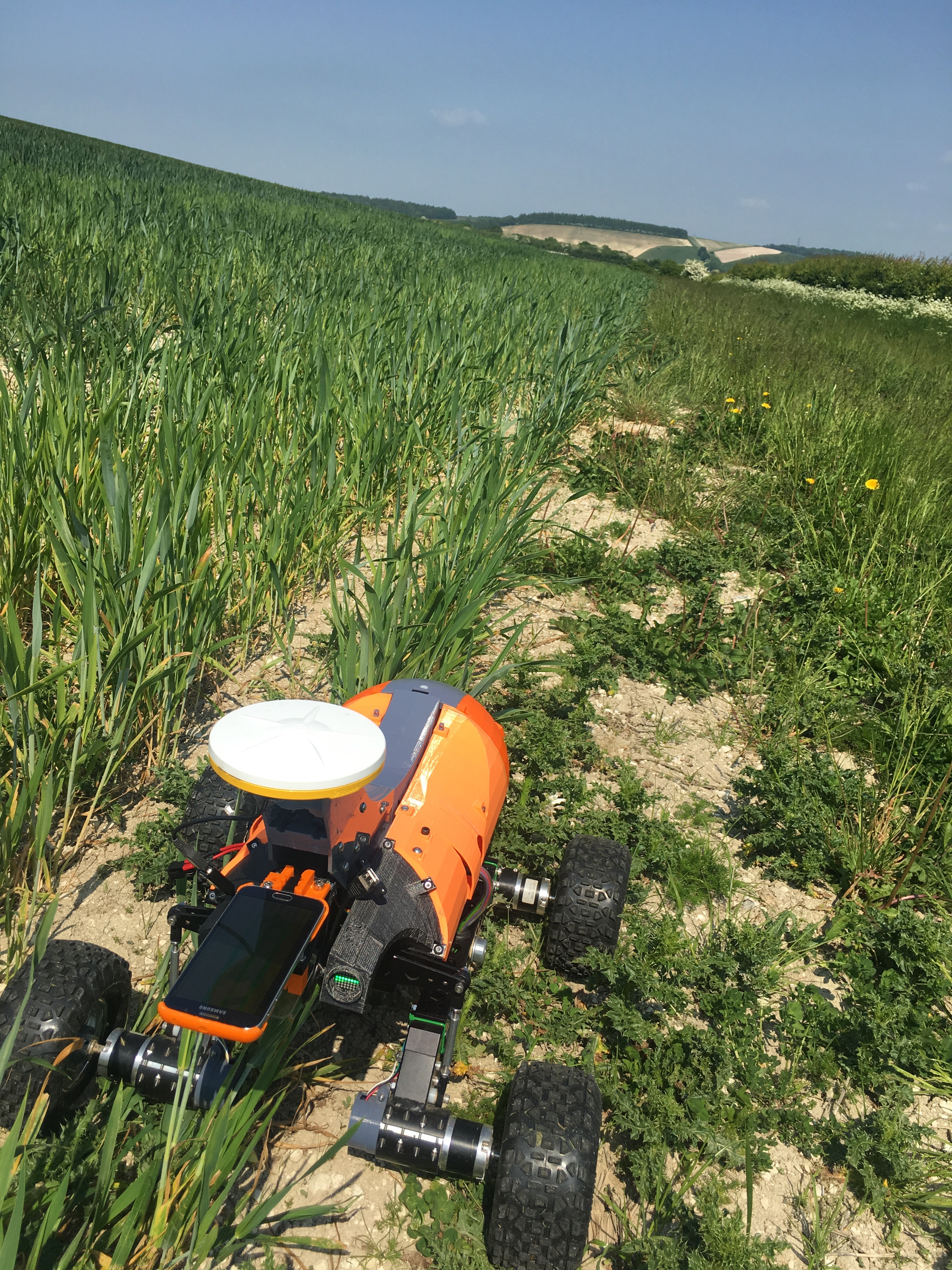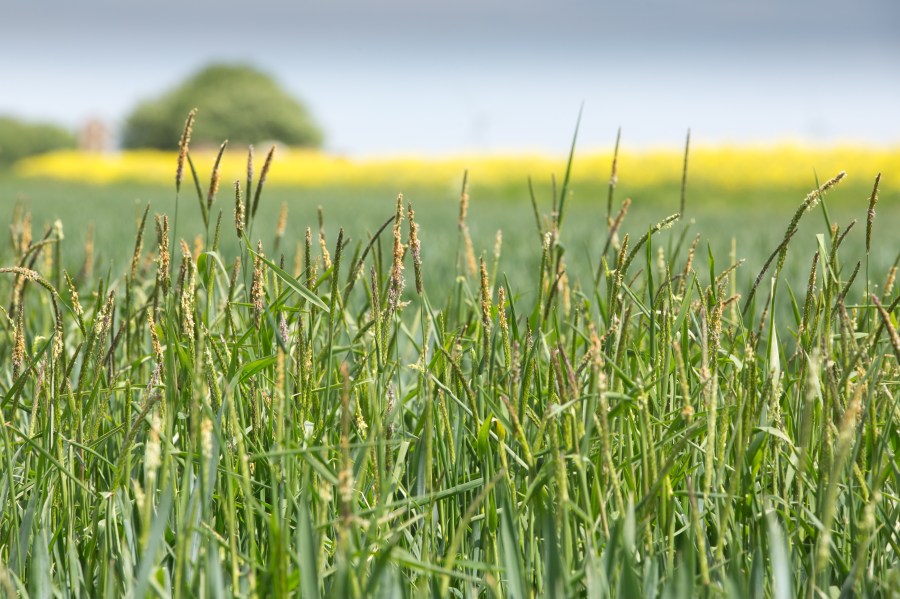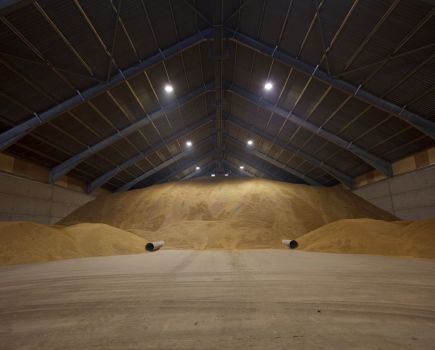An over-reliance on blackgrass herbicides is blamed for leading growers down a blind alley, where they now face a wall of herbicide resistance. AHDB-funded research is looking at the bigger picture to help find the best way forward.
We’ve previously failed to pick up the early signs of a move towards resistance.
By Lucy de la Pasture
For many years the answer to weed problems has been found in a herbicide can and, until recently, it’s been an effective strategy. In some cases, herbicides have become a victim of their own success and a reliance on their use has led to weed resistance developing, with blackgrass being a good example of a weed that has evolved strategies to overcome the effects of many different herbicides.
Understanding the evolution of resistance in blackgrass populations and how management practices impact on its development has been the focus of the Blackgrass Research Initiative (BGRI), a collaborative project between Rothamsted Research, University of Newcastle, University of Sheffield and Institute of Zoology.
Rothamsted’s Dr Paul Neve highlights the key findings from the four-year project, which has been underpinned by a network of 71 farms who have given access to their fields and management data.

The weeds review covers emerging technologies which may take on a major role in weed control in the future.
“In most cases we’ve been able to glean information on agronomic practices within fields since 2005 which has allowed us to overlay the effects of management on the resistance profile of the blackgrass populations in fields,” explains Paul.
As part of the project, researchers from Rothamsted established the extent of resistance to different post-emergence herbicides across the 71 sites. “We found 95% had resistance to fenoxaprop (fop), 55% resistance to cycloxydim (dim) and 75% resistance to ALS-herbicide Atlantis (mesosulfuron+ iodosulfuron).”
By looking at the agronomy information, researchers were able to deduce that herbicide use intensity is the main driver of resistance evolution in blackgrass, regardless of the mode of action.
“Resistance to post-ems in wheat is conferred by a combination of target site resistance (TSR) and non-target site resistance (NTSR), with NTSR being the main mechanism. From the management data we were able to see herbicide diversity doesn’t slow the evolution of resistance.”
This presents a bit of a catch 22 situation when it comes to resistance management, he highlights.
“Herbicide mixtures are associated with reduced TSR, but herbicide mixtures and diversity are associated with higher levels of NTSR. So in effect, by using herbicides you’re selecting for resistance regardless of the chemistry you’re using,” says Paul.
That’s not to say mixtures and rotations of chemistry don’t still have a place, he stresses. “They do but within an integrated approach where diversity is central. This involves diversity in cropping, rotation and tillage because if you expose weeds to the same management practices year-on-year, they will adapt to it.”
The BGRI project also looked at the sensitivity of blackgrass populations to glyphosate and although they found no outright resistance, differences in sensitivity between populations were evident, says Paul.
“Again, we looked at the management history and found the sensitivity of populations was linked to the intensity of glyphosate use. So although we didn’t find glyphosate resistance, we need to take notice because as an industry, we’ve previously failed to be pre-emptive and pick up the early signs of a move towards resistance and change management practices accordingly,” he comments.
But the problem is much wider than just blackgrass, explains ADAS weed scientist Dr Sarah Cook. “UK populations of wild oats, ryegrass, poppy, chickweed and mayweed are all locally resistant to a range of herbicides,” she explains.
“Resistance issues are also emerging in bromes (Anisantha spp. and Bromus spp.), and although it’s not nationally significant, all are increasing in frequency and for individual farmers can present serious problems.”
ADAS weed scientist, Dr Laura Davies, identified a reduced sensitivity to glyphosate in some populations of sterile brome in her PhD, published in Weed Science (2019). She’s also leading an AHDB-project looking at the distribution and sensitivity of brome populations to selective post-em herbicides, which includes the ALS and ACCase groups as well as glyphosate.
“The screening work has shown that there is variability in sensitivity to ALS herbicides but the variability in sensitivity in ACCase’s is much lower. The glyphosate findings haven’t changed from my PhD work, so there’s been no increase in insensitivity,” explains Laura.
“We’re also looking at application at different growth stages of the weed to find out whether herbicide applied when brome weeds are large (GS25+) is pushing the population towards resistance.
“Bromes are different to blackgrass and ryegrasses as they’re self-pollinating rather than out-crossing so this may effect the way resistance evolves,” she adds.
There’s been a cross-over between the BGRI and brome project and in 2017, the BGRI farm network was assessed for the presence of brome. “There wasn’t a lot of brome found and it was mostly sterile and rye brome in margins and headlands. It’s a good example of where there’s already a good approach to blackgrass control, it transfers across and keeps the brome population low as well,” she comments.
Weed control is a problem all sectors are facing and it’s clear the answer to weed control challenges isn’t going to be found in what has become a diminishing pool of active ingredients, says AHDB’s Paul Gosling.
“The recent loss of linuron, for example, has opened up gaps in weed control across the horticultural and potato sectors. Key active ingredients for weed control in sugar beet production, such as phenmedipham and desmedipham, are also at risk of being withdrawn from the market and diquat has already gone, leaving potato growers searching for an alternative approach to desiccation.”
In order to take a wider view of weed control challenges, AHDB commissioned a literature review last year, he explains. The objective was to look at weed control options on a national and international level and identify approaches to benefit UK crop production across all sectors in the short, medium and long term.
Sarah led the project, which has just reported its findings. “Initially we looked at all the different weed control techniques being used across all crops and grouped them into categories,” she explains.
These were cultural controls (eg drilling date), non-chemical controls (eg thermal weeding), chemical controls, novel and emerging technologies (eg robotics), digital tools (eg decision support), genetic tools (eg CRISPR) and preventative weed control strategies (eg in non-cropped areas).
“We identified the key weaknesses in the lifecycles of each weed and then looked at how different control methods will disrupt the growth cycle of the weed. We were then able to propose future strategies for weed control across the industry,” she says.
One of the key findings of the report is that the vast amount of knowledge on weed control that already exists needs to be more accessible to advisors and growers, highlights Sarah.
“There’s more information on weed control known than is readily available or used by advisors and growers. Using current knowledge better is a very high priority, and a key recommendation of the review has been to develop a knowledge-hub for weed control so it’s more easily accessible.”
Knowledge exchange from research to the field is another area identified as ‘could do better’ within the report. Sarah explains, “There’s too great a gap between practical and applied practitioners and fundamental research. The focus for future research should be targeted where knowledge gaps in weed biology are hindering development of better control options.”
Good stewardship of herbicides was identified as being vital across all sectors and the report echoes Paul’s view that there needs to be a more pro-active approach to the identification of high risk uses or situations which could select for resistance.
“Retaining product efficacy, by minimising resistance and ensuring good practice, is something over which agronomists and growers have considerable control,” adds Sarah. “The review highlights that an integrated approach to weed management is the way forward. As an industry we need to become ready to jump before we’re pushed by evolving weed resistances and changes in regulation,” comments Sarah.
To facilitate this, there’s a recommendation that weed management strategies should be agreed and communicated widely. In conjunction, weed control strategies need to be backed up by intelligence so it’s important to monitor weed species for shifts in sensitivity so emerging cases of herbicide resistance can be picked up, according to the review.
“The sheer number of weed control strategies out there show we’re an innovative bunch, but in order to make the switch away from being reliant on herbicides, there needs to be a change of mindset. Currently pests and disease are generally viewed as being more important than weeds, probably because weeds are less catastrophic and don’t necessarily lead to crop failure.”
The review report also suggests government and industry to come together to agree funding for Integrated Weed Management (IWM). Sarah explains there’s a political desire to maximise non-chemical and more integrated approaches – funding is needed but it’s an area that doesn’t attract commercial funding.
The final recommendation is that weed research and approaches to control need to be considered more strategically. “Reviewing and compiling information for this review has highlighted how the current approach to weed control is very often based on specific weeds and/or in specific crops and by using herbicides.
“A key recommendation is that there should be a more strategic approach to weed research and control over the whole cropping system. This will involve putting weed biology and the weed life cycle at the heart of weed control. A cross-sector, multi-annual approach is therefore vital,” concludes Sarah.
Herbicides – part of the problem, still part of the solution
Bayer’s Dr Gordon Anderson-Taylor supports the call for improved knowledge exchange within the industry. “It can help bridge the gap from research to the field and support peer-to-peer learning, which Bayer facilitate through their Partners in Performance programme,” he says.
Both the weed review and brome study are being part-funded by industry and Bayer is a partner in both projects. Gordon believes the brome project is a very necessary and interesting piece of research in to a weed that has been largely neglected by researchers.
“There are very few trials that have looked at brome as a species, and data is very thin on the ground. There’s been a lot of supposition about how resistance may be developing in bromes but no data that’s evidence based.
“This makes the work investigating the relative sensitivity of the different species of brome to different herbicides particularly interesting. Laura’s results will all be new information and help us know what we’re dealing with,” he comments.
Understanding how resistance may evolve in brome will help devise strategies to prevent the weed becoming a problem like blackgrass has become, he believes.
Referring to the BGRI finding that the evolution of resistance in blackgrass has been driven by herbicide usage over the years, Gordon says it’s important not to keep pushing the blackgrass population towards resistance.
“The only way to do this is not to use herbicides but it’s not a position most growers could possibly adopt,” he says.
There’s still a place for herbicides as part of an overall control strategy, he believes, but they must be supported by cultural methods to help manage blackgrass populations. Every season can throw a curved ball when it comes to blackgrass control, and the past few autumns have been very kind – enabling delayed drilling without problems and with sufficient soil moisture to get good results from pre-emergence herbicides.
“When blackgrass populations are low enough, then herbicides can still do what they’re supposed to do,” he adds.
Research roundup
AHDB Project No 1807258, ‘Review of weed control options for UK crops’ ran from Sept 2018 – Jan 2019, at a total cost of £43,000 (AHDB £26,000) in partnership with BBRO, FMC, Bayer, Syngenta, Belchim, Corteva, BASF and United Phosphorus, PGRO and Maize Growers Association.
AHDB Project No 211200059, ‘Investigating the distribution and presence, and potential for herbicide resistance of UK brome species in arable farming’ runs from March 2017 to Feb 2021 at a cost of £218,000. ADAS are leading the project in partnership with Rothamsted Research, BASF, Bayer and Corteva.
AHDB Project No 20123807, ‘Multiple herbicide resistance in grassweeds: from genes to agro-ecosystems’, ran from April 2014 to March 2018. Led by Newcastle University, scientific partners include Rothamsted Research and Universities of Sheffield, Reading, Oxford and York. Its total cost is £2.8M, funded by BBSRC and AHDB (£280,000). For more information, see www.bgri.info




